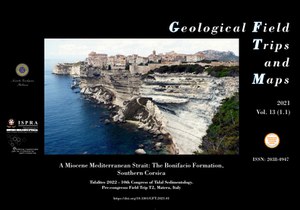A Miocene Mediterranean Strait: The Bonifacio Formation, Southern Corsica
Tidalites 2022 - 10th Congress of Tidal Sedimentology. Pre-congress Field Trip T2, Matera, Italy
The Bonifacio Basin trip is part of the 10th International Congress of Tidal Sedimentology (Tidalites), Matera, Italy, 2022. The guide aims at documenting a number of selected outcrops located along the cliffs forming the Corsican side of the Corsica-Sardinia Strait. The objective is to illustrate the evolution of sedimentary dynamics of the Miocene deposits, which were emplaced above the crystalline Paleozoic basement of the strait. After an initial stage of volcanoclastic sedimentation locally preserved above the basement, two third-order sequences of marine deposition are recorded. The first one, dated to the late Burdigalian, is dominantly composed of wave- dominated siliciclastic deposits and shoreface-attached patch reefs. The second one, dated to the Langhian, has an upward increase in clastic carbonates, progressively dominated by red algae. While wave dynamics still dominates in the lowstand shoreface deposits of this sequence, currents progressively arise as water depth increases, finally forming very large submarine dune fields migrating toward the west, a direction parallel to the present-day strait. Cross-bed geometry and carbonate fabrics suggest a tidal origin for these deposits. It is suggested that the Langhian transgression, together with a tectonic drowning of the strait, was responsible for the propagation of the Western Mediterranean tide into the Corsica Basin (the former Tyrrhenian Sea). Tidal currents were progressively damped after the Miocene, due to the uplift of the eastern part of the strait, where the basement emerged in the Lavezzi and Maddalena Islands.
DOI: https://doi.org/10.3301/GFT.2021.01

